Recently Digitised Material: October-December 2020

WARNING: Aboriginal and Torres Strait Islander viewers are advised that this post contains images and voices of deceased persons.
This blog features some of the recently digitised items from the Tasmanian Archives and the State Library of Tasmania. Each year, we place items online to help promote and preserve our rare and special collections. These images and films are just a tiny sample of an amazing treasure trove of Tasmania’s heritage. From colonial artwork to convict records, fragile glass plate negatives to rare films, private letters to government records, our collections (including the Allport Library and Museum of Fine Arts and the W L Crowther Collection) tell millions of stories from Tasmania and around the world.
Read on to find out more about our new additions to our digital collections! To discover even more, you can also search our catalogue or visit us on Flickr and YouTube.
In this blog:
- Peter Laurie Reid Carte-De-Visite Collection, c1860 – Ref: NS1442/1/1 to 53
- Australasian Antarctic Expedition, 1911-1914 – Ref: NS6607/1/1 to 14
- Stereoscopic Photographs of Emu Bay Burnie, c1890 – Ref: NS6664/1/1 to 5
- Stereoscopic photographs taken by George Benjamin Davies for submission to the Postal Stereoscopic Society of Australia, c1921 – Ref: NS6538/1/1 to 33
- Tasmanian Government Tourist Bureau photographs – AA375
- Photograph of Fanny Cochrane Smith and Horace Watson recording Tasmanian Aboriginal Songs: NS1553/1/1798
- Illustrated Travelogue July 1919 – Ref: NS6853
- Fountain in Governor’s garden, Port Arthur – Allport Library and Museum of Fine Arts
- Drawing of George Meredith, Senior – Ref: LMSS12/1/72
- Photographs from the Trustees of the Tasmanian Public Library – Ref: SLT23
- Wills Image Replacement Project: AD960/1/1
- Diary of Police Duties kept by Charles H. Brown, District Constable, Coal Mines, Tasman Peninsula 1853 – Ref: CON129/1/1
- Index to General Correspondence, 1836-7 – Ref: CSO4
Newly Digitised Images
Peter Laurie Reid Carte-De-Visite Collection, c1860 – NS1442
Photographs of various views from the Peter Reid Collection, mostly around Tasmania, during the 1860’s. Featuring Launceston, Oatlands, Deloraine, Ross, Hobart and Bothwell.
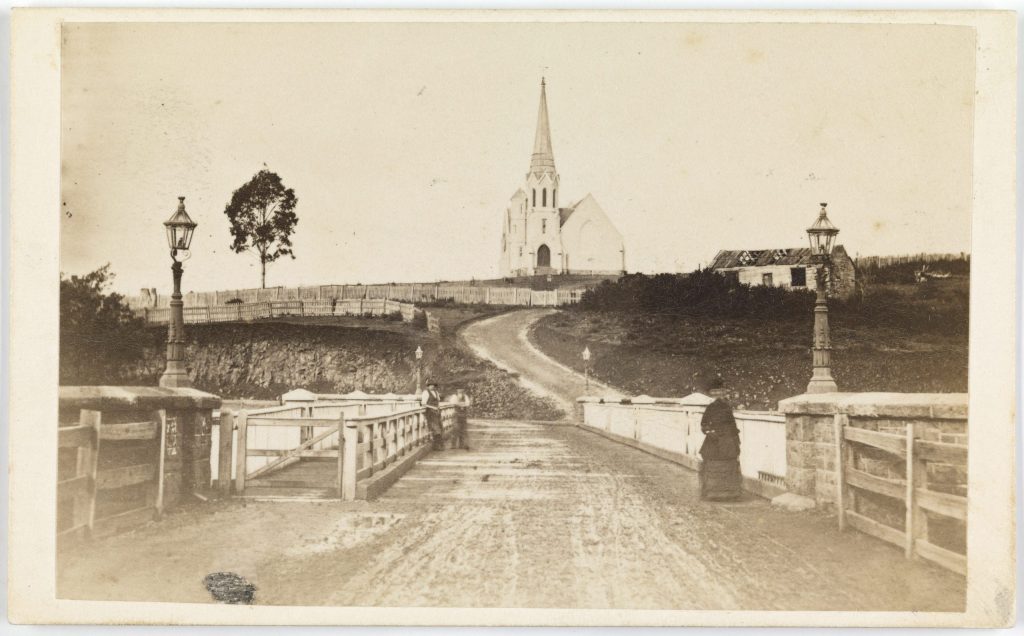
Peter Laurie Reid, a professional portrait and travel photographer, first set up his photographic business of P.L. Reid & Co., in Hobart in 1864. His partner, Matthew Patrick Dowling, left on unfriendly terms, and for years, the two men continued to spar in the pages of the Hobart Town press, during which the two men came to be known as ‘Federal Dowling’ and ‘Confederate Reid’ in reference to the ongoing American Civil War. (Source: https://www.daao.org.au/bio/peter-laurie-reid/biography/)
Highlights from this series (NS1442) can be viewed in Flickr.
Australasian Antarctic Expedition, 1911-1914 – NS6607
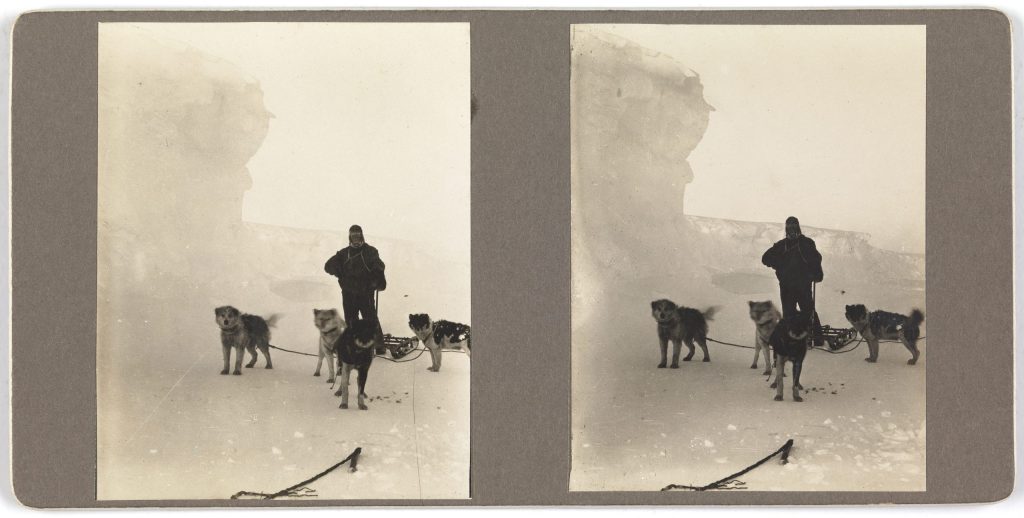
Huskies in the Antarctic 1911-14 [Training dogs on the floe beneath the Shackleton Shelf] / Photographer A Watson (NS6607/1/1)
14 stereoscopic photographs taken by Andrew Watson on the Australasian Antarctic Expedition 1911-1914. Watson was based with the Western Base Party, Queen Mary Land. Watson was a geologist who spent his time in this expedition studying glacial ice and exposed rock, and training sled dogs. Images in this collection include the Aurora leaving Hobart, voyaging to Antarctica, and images of Queen Mary Land and the base there. The prints, from glass slides mounted on card, were collated by Sir Douglas Mawson. The State Library of NSW also holds copies of eight of the fourteen images in their collection ‘Home and Away’.
The Aurora was refitted in London before sailing to Hobart where the team members boarded her. The Aurora departed on the 2nd of February 1911 from Hobart for Macquarie Island. After leaving Macquarie Island on the 23rd of December, they reached Antarctica on the 7th of January. Unloading supplies at Cape Denison, the Aurora soon left to take the eight man Western party, including Watson, 1500 miles further along the coast. The expeditioners remained at Antarctica until mid-December 1913 and arrived back in Hobart on February the 26th.
There is a vast array of books on the Australasian Antarctic Expedition in the Libraries Tasmania catalogue.
Stereoscopic Photographs of Emu Bay, Burnie (c1890) – NS6664
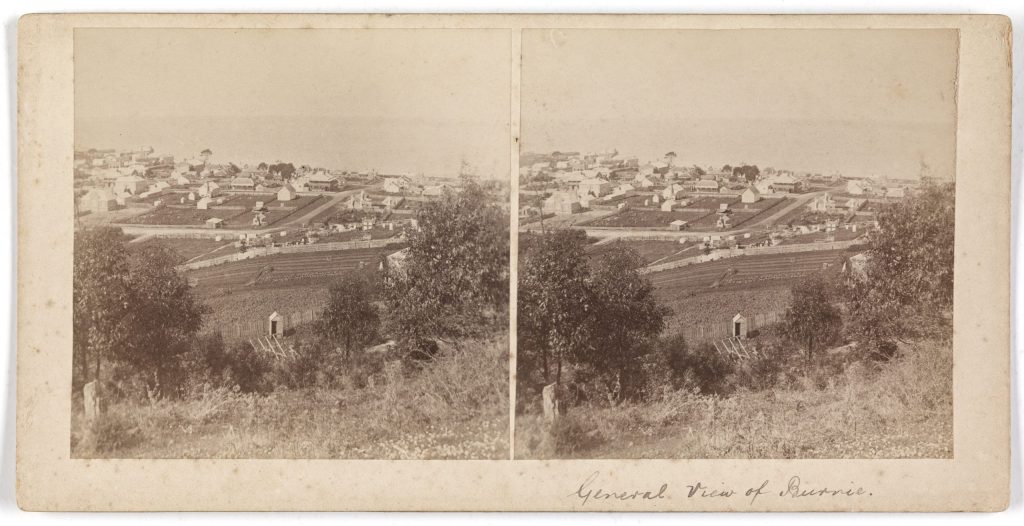
Collection of 5 stereoscopic photographs by William Pousty. Four are of Emu Bay (now Burnie), North West Coast of Tasmania, Pousty had a studio in Emu Bay in 1889-91 so it is likely the images date from this time. One image is of Campbell Town. It is attributed to Pousty as the handwriting on the back resembles Pousty’s other inscriptions. The ‘Captain Barry’ depicted in one photograph is Captain W Jackson Barry who toured Tasmania in 1889. Information on his visit can be found in the Daily Telegraph, 28/8/1889, p.3.
Stereoscopic photographs taken by George Benjamin Davies for submission to the Postal Stereoscopic Society of Australia, c1921 – NS6538
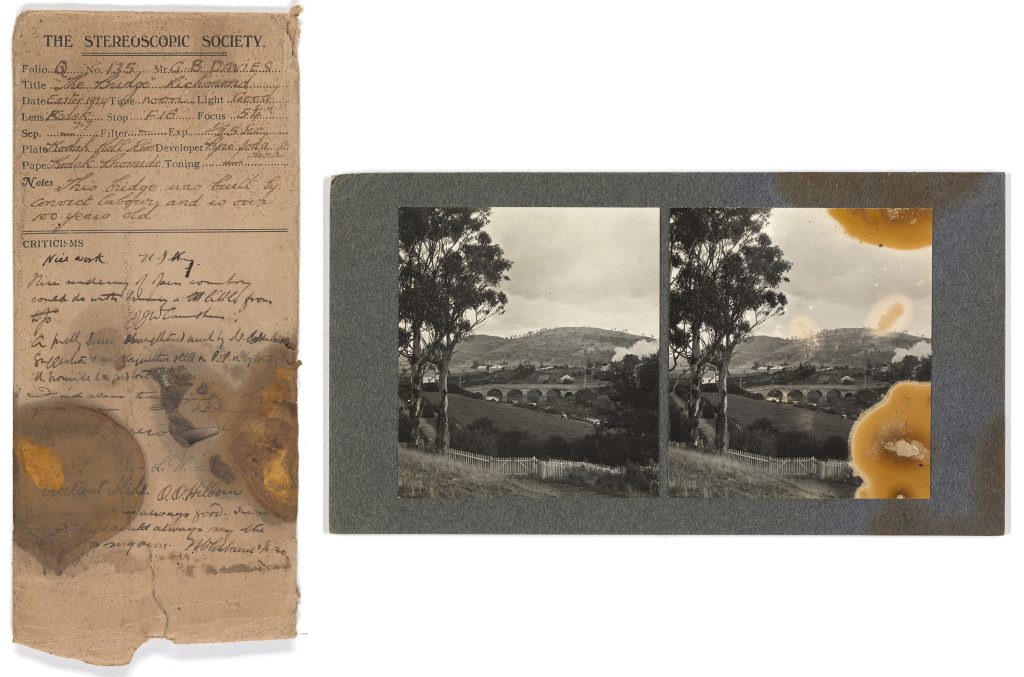
The Bridge, Richmond Tasmania – Folio Q, No.135 (Ref: NS6538/1/28)
Set of 33 photographs featuring landscapes around Tasmania. Each item is pasted onto card and contained in an envelope entitled ‘The Postal Stereoscopic Society of Australia’. The front of the envelope contains information about the image – the first part supplied by Davies, and the second supplied by ‘Critics’. Davies wrote in a folio number, title, exposure details, paper used, and notes. Critics added handwritten short one or two line feedback on the image, including their name.
Tasmanian Government Tourist Bureau photographs – AA375
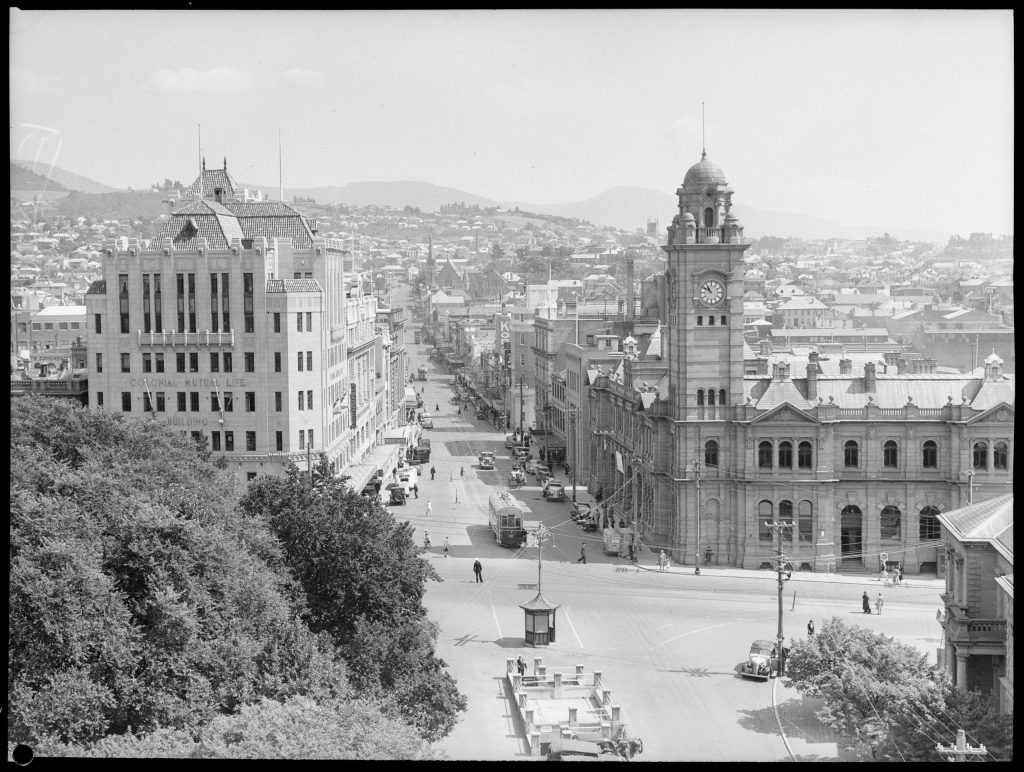
Photographs, Glass Plate Negatives, Stereoscopic Slides and Negatives used by Tourism Agencies to Publicise Tasmania. The Tasmanian Government Tourist Bureau was established in 1934. It operated the “Lakes” Guest-houses and a network of branches in Hobart, Launceston and Burnie in Tasmania and Melbourne, Sydney, Adelaide and Brisbane on the mainland. It opened several more branches to provide booking services and ticket sales over the summer months and closed for the winter.
With the decline in tourism at the onset of World War II, the Bureau closed all but its Hobart, Launceston, Melbourne and Sydney offices. They did not re-open until the post-war boom began in 1946.
The photo series includes famous Tasmanian landscapes and tourist attractions. It also contains images of Hydro-Electric power stations and other infrastructure, and a few examples of other Tasmanian industries, sporting and leisure activities. Highlights from this series (AA375) can be viewed in Flickr.
Photograph of Fanny Cochrane Smith and Horace Watson recording Tasmanian Aboriginal Songs: NS1553/1/1798

Fanny Cochrane Smith was a Tasmanian Aboriginal woman who was born on Flinders Island in 1834. She lived for the first few years of her life with her mother Tarenootairrer at Wybalenna, together with her older sister Mary Anne. When she was seven years old, she was taken away to the Orphan School in Hobart. In 1847, Fanny and her family were moved to putalina/Oyster Cove. She married William Smith (a former convict) in 1854 when she was aged 20, and they settled in Nicholls Rivulet, where they had twelve children. Fanny Cochrane Smith’s many descendants are a cornerstone of today’s Aboriginal community, and she has been called a “matriarch of survival.”
Fanny Cochrane Smith was devoted to the preservation of Tasmanian Aboriginal language and culture. She spent a great deal of time with the Nuenonne elder Truganini/Trukanini learning bushcraft at her home at Nicholls Rivulet, where William Lanne also visited her regularly. When Fanny’s mother Tarenootairrer died in 1858, Truganini took on the responsibility for teaching her grandchildren (Fanny’s children) traditional songs, stories, and skills. Fanny Cochrane Smith was also a skilled maker of traditional shell necklaces, a living tradition that continues to this day. She was also the last surviving fluent speaker of a Tasmanian Aboriginal language (of which, at the time of contact, there might have been as many as 16).
In 1899, Fanny Cochrane Smith gave a remarkable performance in Hobart of traditional songs. Present in the audience was Dr. Horace Watson, who begged her to record the songs on a brand-new piece of technology – the Edison wax cylinder. She embraced the idea and between 1899 and 1903, they made several recordings of these “songs of survival.” A century later, scholars used these recordings together with a wealth of other sources to reconstruct palawa kani – the only Aboriginal language in lutruwita/Tasmania today. For more about this research, please see this information from the Tasmanian Aboriginal Centre. In 2017, Fanny Cochrane Smith’s recordings were officially inscribed on UNESCO’s Australian Memory of the World Register.
Illustrated Travelogue, July 1919 (NS6853)
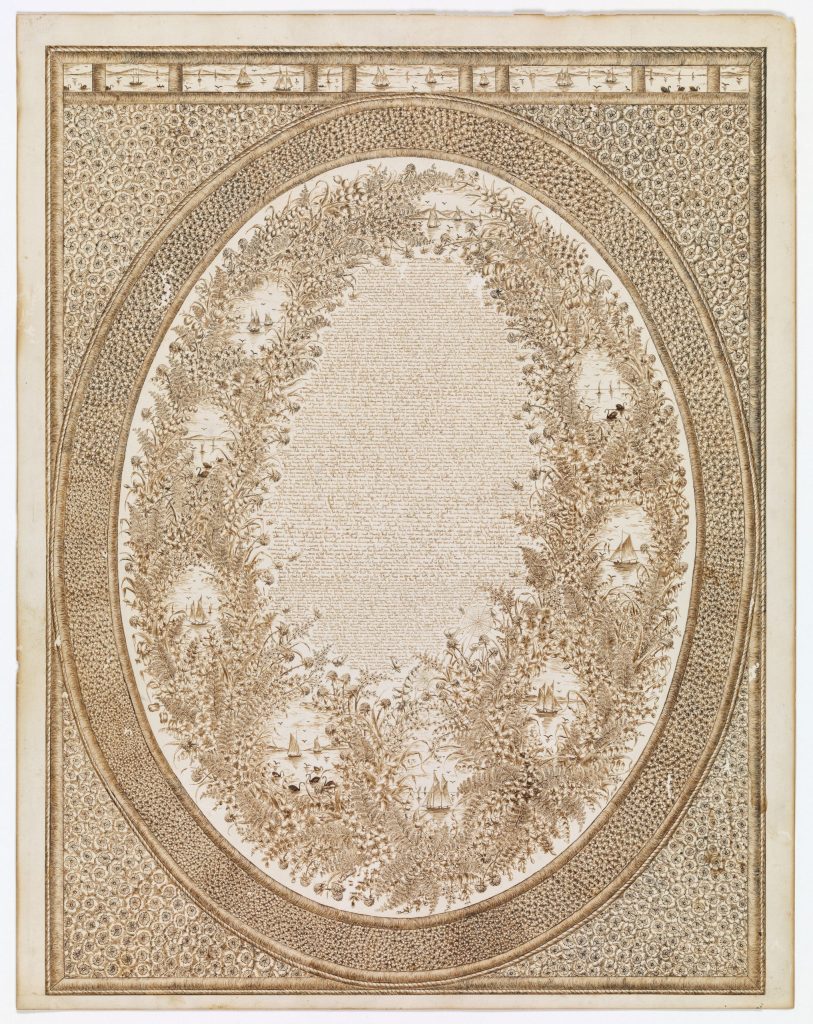
A work of ink on bristol board describing a trip to Hobart and surrounds 1918/1919. The Derwent River, a mountain climb, Kingston Beach and Bellerive are all noted in this incredibly detailed work of art and narrative. The focus of the text is on beauty, place, and nature. There is a note within the text stating that the work took 128 hours from 3/12/1918 to 17/2/1919. The work appears to be signed ‘Fred W Ashton B Henry, 17/02/1919
Fountain in Governor’s garden, Port Arthur (Allport Library and Museum of Fine Arts)
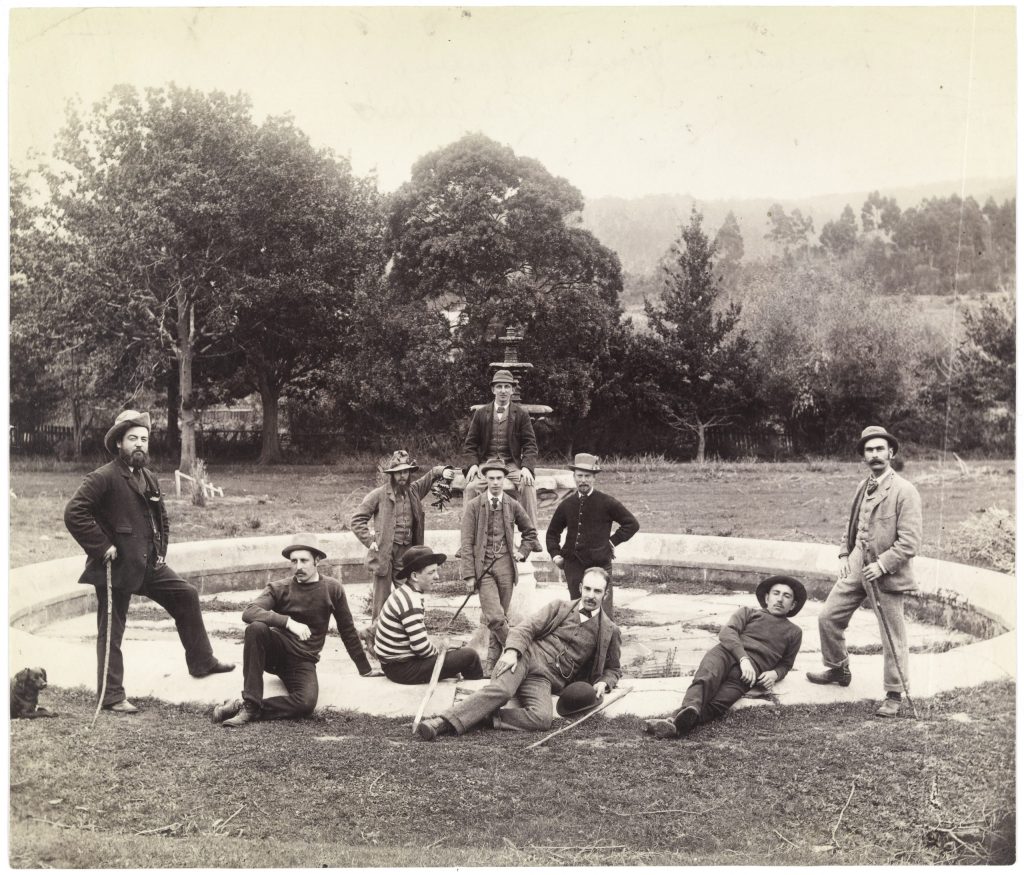
Digitised as part of our current Allport exhibition, Libraries Tasmania is thrilled to present this light-hearted look at men’s facial hair fashion. We invite you to discover the wonderful moustaches – and other hidden treasures – that lie just “under your nose” in the Allport Library and Museum of Fine Arts and within the Libraries Tasmania collections. View the exhibition online here.
Visit the exhibition in the Allport Library and Museum of Fine Arts, 91 Murray Street Hobart. The exhibition runs until February 2021.
Drawing of George Meredith, senior – LMSS12/1/72

George Meredith (1777-1856) arrived in Van Diemen’s Land in 1821, aboard the Emerald with his second wife and five children, and they settled on the East Coast of Tasmania at Great Swanport. A further 3 children were born in the colony. Meredith was involved in farming, whaling, sealing, and shipbuilding and was active in colonial life. He built the homestead ‘Cambria’. Several of the Meredith family became prominent in the life of the colony. George’s second son, Charles, was appointed colonial treasurer of Tasmania in 1857 and continued in public service for twenty years. He married his cousin Louisa Ann Twamley, artist and author. Their children Owen and George Campbell became explorers and prospectors and Owen’s son, David, was general manager of the Electrolytic Zinc Works from 1926 until 1942. George Meredith’s fourth son, John, was appointed a magistrate at Swansea in 1855 and the fifth son, Edwin, emigrated to New Zealand as a pioneer colonist in 1851. George’s daughter Clara, married Sir Richard Dry, the first Tasmanian-born premier. The Tasmanian Archives holds a selection of the Meredith Family papers (NS123).
The artist of this drawing is unknown, but the image comes from the papers of Archdeacon William Henry Browne. Portraits often contained hints of the subject’s occupation, and and this one appears to be hinting at Meredith’s whaling interests. He appears to be holding a spear like those used by whalers, and the crudely drawn beast at his heels is probably intended to be a whale.
Photographs from the Trustees of the Tasmanian Public Library – SLT23
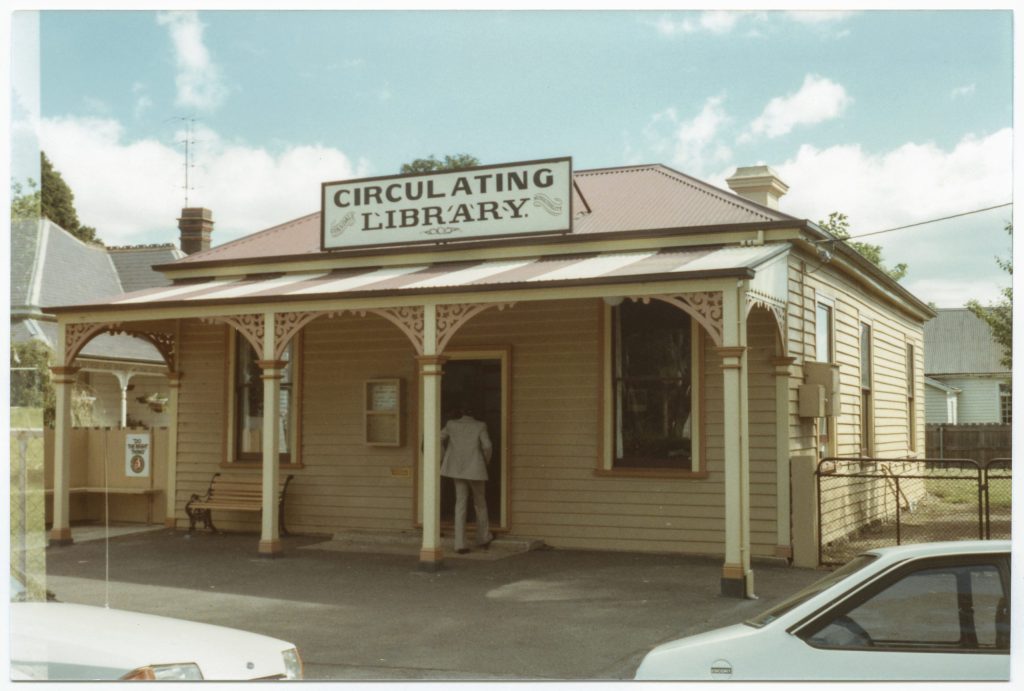
Series SLT23 contains photographs, drawings and negatives from the Trustees of the Tasmanian Public Library dating from the 1850s. Take a step back in time and find photos of your regional library, or explore the early beginnings of libraries in Tasmania with original building and staff photos. Explore highlights from this series (SLT23) on Flickr.
Volumes
Wills Image Replacement Project

Access to our early wills dating from 1828 will see a new lease of life with pages from the early volumes of the AD960 series being replaced with higher quality images. Wills from AD960/1/1 are now available to view online via the Tasmanian Names Index.
Diary of Police Duties kept by Charles H. Brown, District Constable, Coal Mines, Tasman Peninsula 1853 – Ref: CON129/1/1
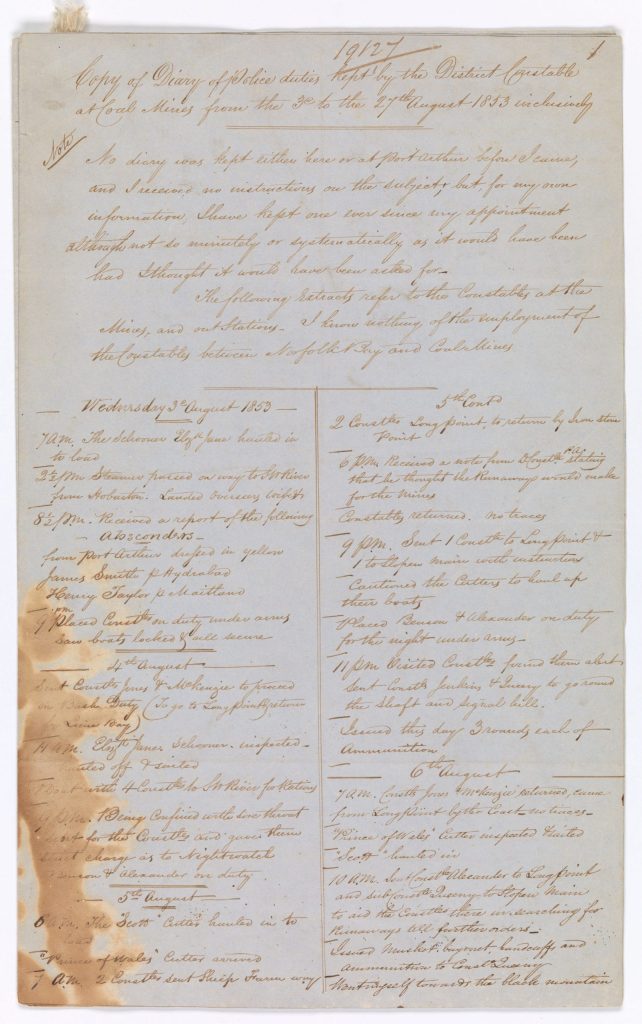
A collection of extracts from the diary of District Constable for the month of August. The document is prefaced by a defensive note stating that the Constable was not required to keep a diary and that no diary had been kept before his appointment. These extracts provide an interesting picture of the duties involved in surveilling the convicts. They were most likely requested from D.C Brown to reflect on a search for 3 runaway convicts who escaped Port Arthur in a fishing boat on the 3rd of August and remained elusive throughout the month. By the 28th, D.C Brown reported:
‘The constables are now completely exhausted. Not one has had his clothes off since the 23rd and have have had no sleep for the last 24 hours.’
Tasmanian Archives: CON129/1/1 p. 6
Index to General Correspondence, 1836-7 – CSO4
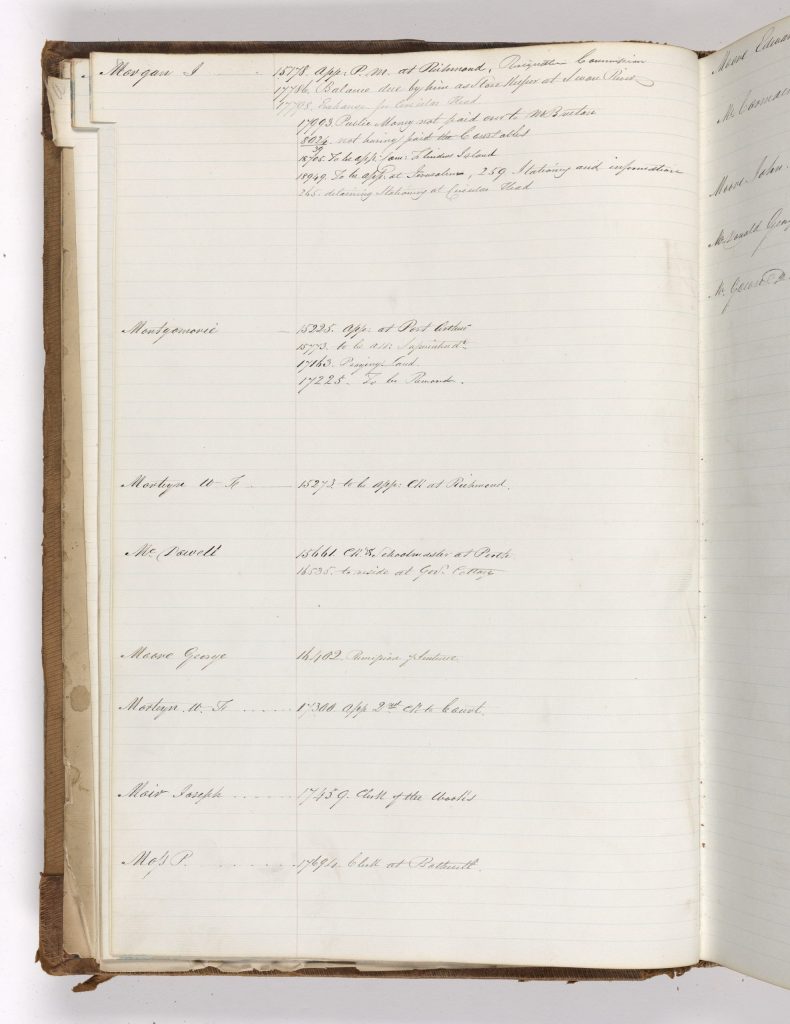
This index refers to the correspondence of the period of Lieutenant-Colonel Kenneth Snodgrass, who administered the government after the departure of George Arthur from 31 October 1836 until 19 January 1837 when Sir John Franklin arrived in the colony as the new Lt. Governor. The file numbers listed refer to files in CSO1: Colonial Secretary’s General Correspondence. For more information about the series and how to use it, please see our Guide to Government Administration – Early Years and also the detailed Guide to the Colonial Secretary’s Office Records.
A note about permissions
We love it when people use our resources. If you’d like to use our images or films in your book, manuscript, documentary, blog, or social media, please do make sure that you ask permission first. You can find out how to do this on our Writers and Publishers page (which has a link to the permission form).
Please feel free to ring us for advice or help. You can find our telephone numbers and chat service on our Help Desk.


I have had a look at the Reid photos(after sending the note about the date of the Baptist Church). The Church is in the photo which is titled as the Deloraine Library(?) 1442/1/23
Thank you Peter, you are quite correct. I have referred this to our collections area who will review our descriptions.
The estimated dates for photos in the Peter Reid collection are not all correct. The Baptist Church @ Deloraine was constructed in 1880. The date is on the front of the building.
A minor point, but in the George Meredith section you say his son Charles became colonial treasurer of Van Diemen’s Land in 1857. VDL was officially re-named Tasmania in January 1856.
Thank you Felicity. This will be corrected.